Abruzzo’s Trabocchi Coast is home to many wonders. Explore our top ten things to see and do along this glittering coastline…
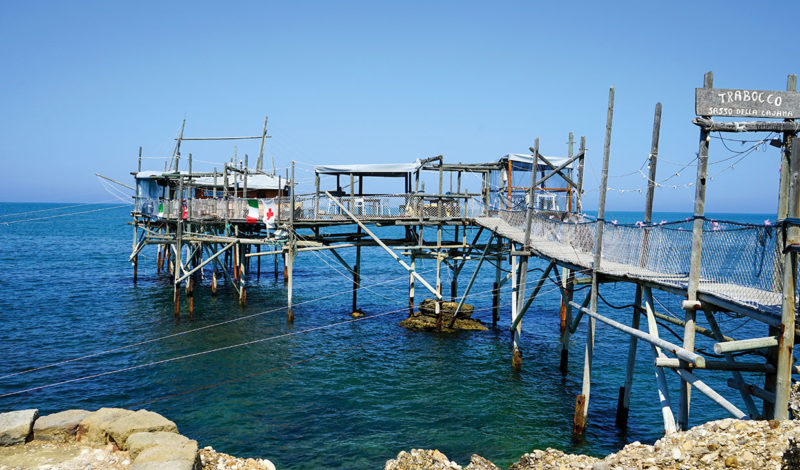
Picture this: a stretch of coastline where the blue shades of the sea blend with the sky, and as you wander along the shore, the salty breeze mingles with the aroma of freshly cooked seafood from the kitchens of seaside restaurants. And there, right before your eyes, the trabocchi come into view – ancient fishing machines standing proudly along the coast.
Their weathered wooden walkways extend over the sea, while long wooden arms hold intricate nets to catch the fish. It’s a spectacle that reveals tales of time-honoured traditions passed down through generations.
We are on the Trabocchi Coast, a hidden treasure nestled in the Abruzzo region. Located between the beautiful towns of Ortona and Vasto, along the Adriatic State Road, this coastal gem spans a mere 40 kilometres.
Yet within this short distance lies a myriad of wonders waiting to be uncovered, including charming villages, cultural landmarks, nature reserves, some of Italy’s best beaches, and countless stories.
Val Nicastro takes us on a journey through her top ten of Abruzzo’s Trabocchi Coast:
1. The trabocchi that give the coastline its name
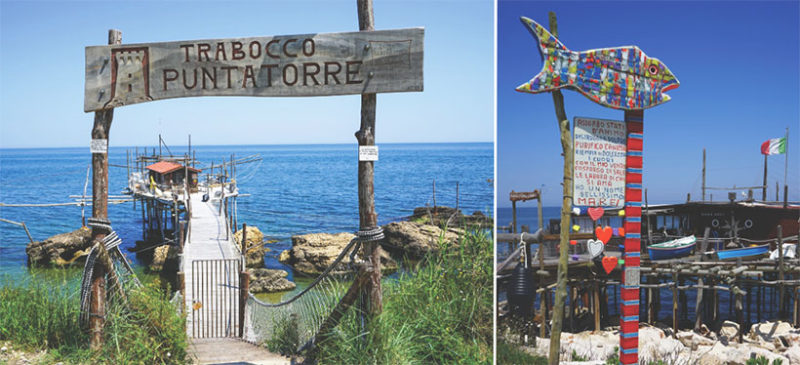
These intriguing fishing machines are a truly unique spectacle that never fails to amaze. While their origin is often attributed to the Phoenicians, their exact beginnings remain uncertain.
What we do know for sure is that the trabocchi were conceived by an imaginative mind, as they were designed to catch fish without relying on sailing or being affected by inclement weather.
They even captured the fascination of the renowned poet Gabriele D’Annunzio as he wrote his novel The Triumph of Death. In a quaint house in San Vito Chietino, he was enthralled by the ‘colossal spiders’, as he vividly described them.
Today, as modern fishing techniques dominate, many trabocchi have been transformed into exclusive dining establishments where you can indulge in delicious seafood while being serenaded by the rhythmic crashing of waves. And if you’re lucky, you might even take part in fishing demonstrations.
Along this coastline, over 20 trabocchi can be found. Notable among them are the Trabocco Mucchiola, the Trabocco Punta Tufano, the Trabocco Turchino (the oldest along the coast), and the Trabocco Punta Cavalluccio, founded by the Verì Family, who are the oldest among the traboccanti families (the owners of a trabocco).
2. The charming and historic town of Vasto
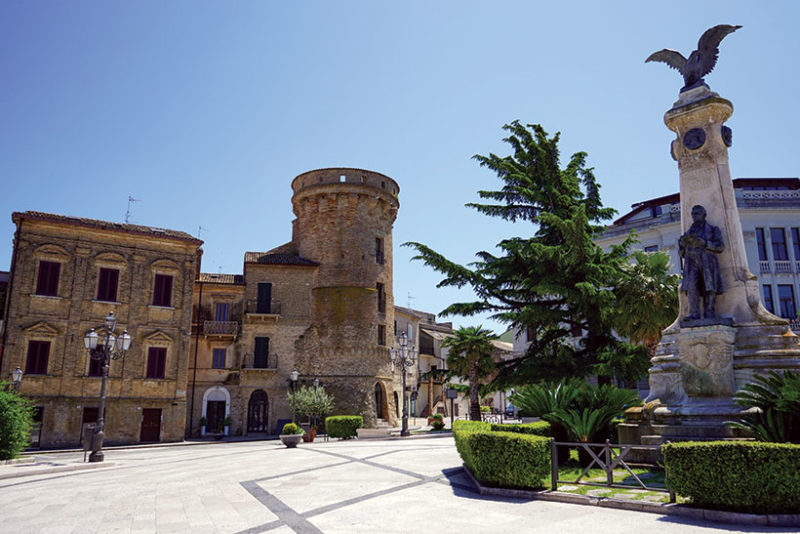
Situated at the southern end of the Trabocchi Coast, Vasto is a charming town blending mythology, history, and beauty. Legend has it that it was founded by the valiant Greek hero Diomedes.
Its town centre dazzles with splendid buildings like the Caldoresco fortress and Palazzo d’Avalos, which houses the civic museums and a stunning Neapolitan garden perched on the edge of the shimmering sea.
The city’s cathedral preserves the relic of Jesus’ Holy Thorn, while the bustling Santa Chiara market offers a taste of local life, between tantalising flavours and lively conversations.
Yet, amidst all these marvels, Vasto’s crown jewel awaits at Loggia Amblingh, a gorgeous belvedere where sea and sky unite in perfect harmony. And as if that weren’t enough, you’ll also find Roman Baths from the 2nd century AD revealing a magnificent 170 sqm mosaic of the mighty god Neptune.
3. The nature reserves of Europe’s Green Region
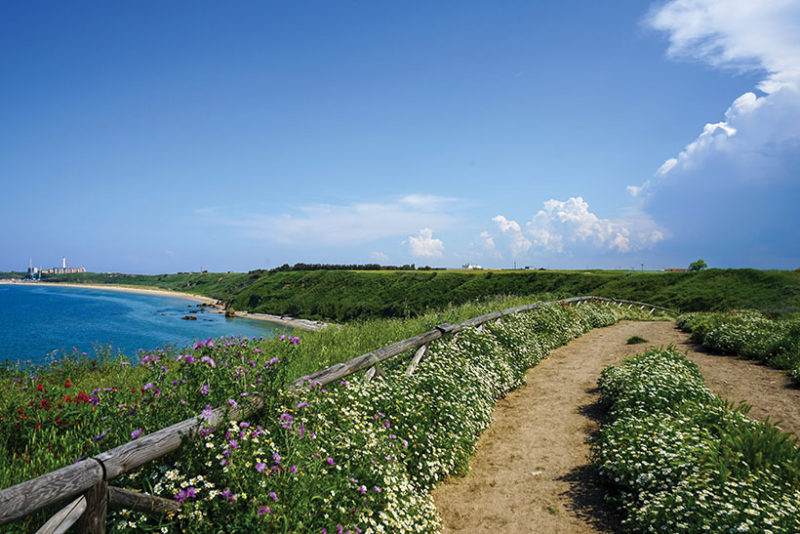
Abruzzo proudly holds the title of Europe’s Green Region due to its abundance of fabulous natural wonders. The Trabocchi Coast, in particular, comprises an impressive collection of seven remarkable nature reserves.
One of the crown jewels is Punta Aderci, a captivating protected area that stretches across 285 hectares between Vasto harbour and the mouth of the Sinello River near Casalbordino.
Within its idyllic landscape, the endangered Kentish plover finds refuge, colourful blooms adorn the land, and the Halymenia floresia, the Mediterranean’s most beautiful red algae, thrives. Nestled within the reserve lies one of Abruzzo’s most stunning beaches, Punta Penna.
4. Villages brimming with history and culture
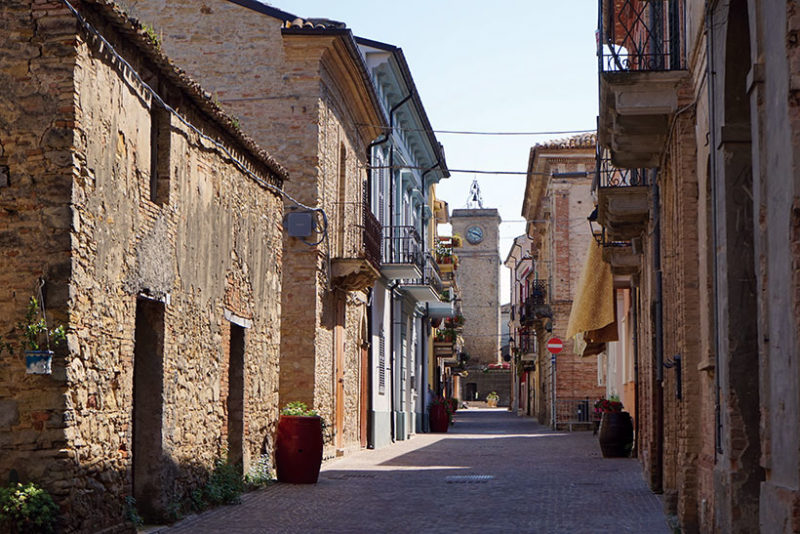
Beyond its stunning seascape and natural beauty, the Trabocchi Coast is absolutely full of enchanting villages steeped in history and captivating culture.
San Vito Chietino, for example, unveils the rustic abode that housed the poet Gabriele D’Annunzio and his lover Barbara Leoni in 1889, providing a glimpse into their passionate liaison and offering a unique view of the legendary Turchino Trabocco.
Rocca San Giovanni perches atop a rocky promontory, embraced by medieval walls. It’s considered one of Italy’s most beautiful villages, surrounded by lush vineyards and olive groves.
Continuing the journey further south, San Salvo awaits on the border with Molise, boasting an archaeological park that takes you on a time-travelling adventure through the Roman and medieval ages as you explore the remnants of ancient civilisations.
5. Uncrowded beaches for soaking up the sun
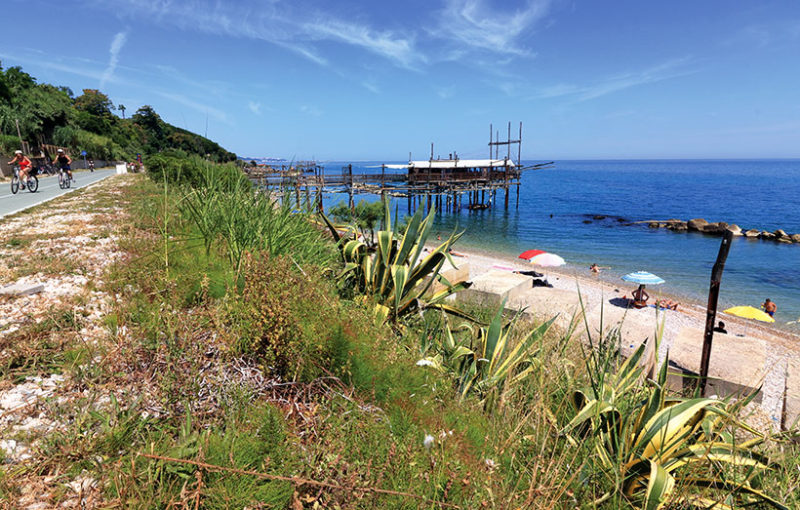
The Trabocchi Coast boasts crystal-clear waters that gently embrace sandy beaches, pebbled nooks and hidden bays. One gem is Cala Turchino, nestled near the ancient Turchino trabocco and boasting turquoise waters that offer a glimpse of an enchanting underwater wonderland.
Another treasure worth exploring is Ripari di Giobbe, known for its secluded location that has helped preserve its heavenly natural environment.
If you’re an avid snorkeler, Valle Grotte offers a pebble beach and vibrant marine life thriving in the deep, crystalline sea. And if you dive near the Punta Tufano trabocco, you’ll be rewarded with the sight of the ‘Christ of the Abyss’ sculpture.
6. Ortona, gateway to the Trabocchi Coast
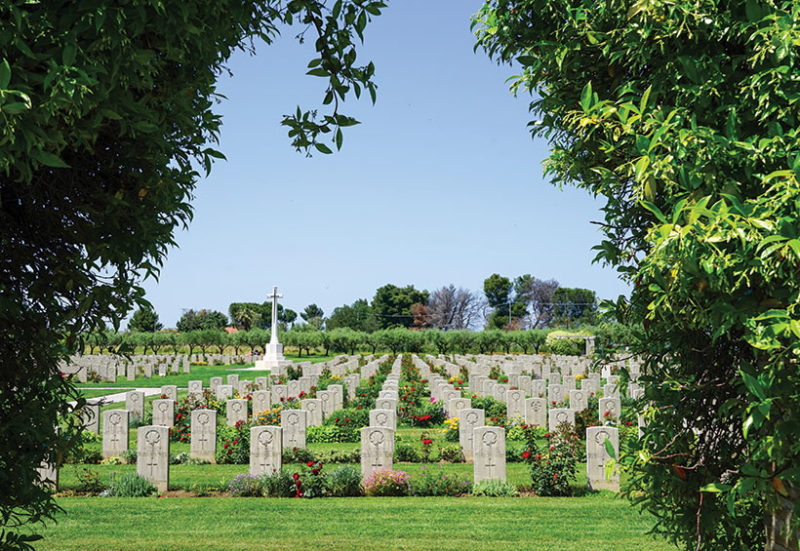
Ortona, the first town on the Trabocchi Coast as you journey from the north, is a key port in Abruzzo. It features a majestic cathedral housing the sacred relics of Saint Thomas, a medieval centre with a magnificent Aragonese castle and a modern section with Liberty-style buildings.
But Ortona’s significance goes beyond its beauty. The town witnessed a fierce battle between Allied and German forces during World War II, memorialised at the Canadian War Cemetery nearby, which commemorates the soldiers who fell in the fighting.
Another interesting place to visit is the Dora Marchese Winery, just beyond the city limits. Here, you’ll find a fountain that freely pours the renowned Montepulciano d’Abruzzo wine, inviting you to indulge in the region’s rich winemaking traditions.
7. Ride along the Trabocchi Coast, the Green Way
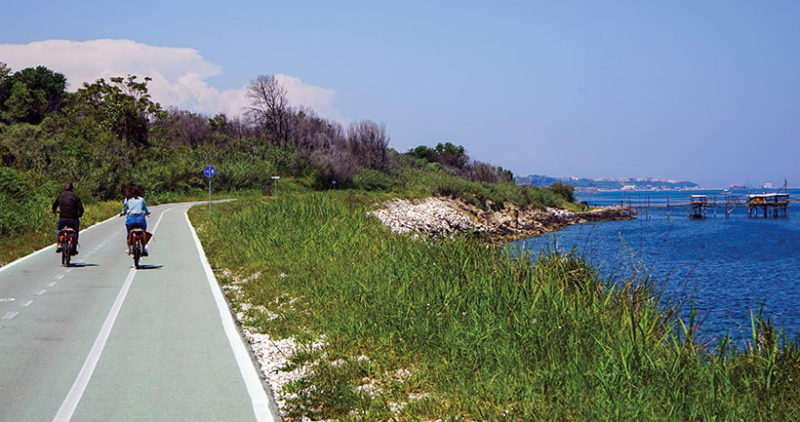
Recently inaugurated, the Green Way is a stunning cycling and pedestrian trail that spans the entire Trabocchi Coast. It follows the former railway track that ran parallel to the coast until 2005, offering a truly unique perspective on the trabocchi.
Stretching for 42 km from Ortona to Vasto, this route winds through nine towns and showcases 25 trabocchi along the way. The predominantly flat terrain ensures a pleasant and effortless journey, complemented by well-placed signage, illuminated tunnels, and gorgeous sea views.
Whether you prefer a leisurely stroll or an invigorating bike ride, there’s really only one guiding principle. You need to take it slow, savour the mesmerising landscapes, and relish the local cuisine. And don’t forget to take a refreshing dip in one of the hidden coves.
Along the route, you’ll find many shops offering a range of bicycles for rent. Options include classic models, e-bikes, and convenient trailers or child seats for those travelling with little ones. The Green Way is also well-equipped with bars and restaurants where you can take a break and recharge, surrounded by scenic views.
8. The Vastese-style brodetto fish soup
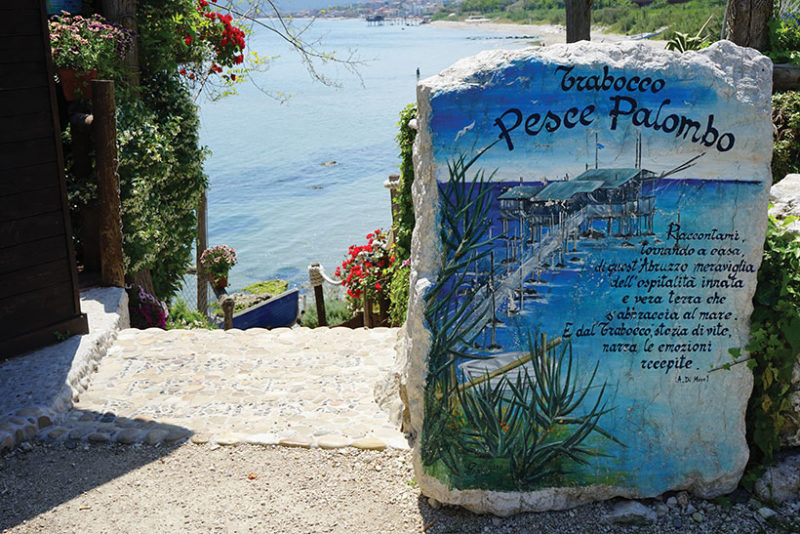
Throughout Abruzzo, you can indulge in excellent cuisine, and the Trabocchi Coast is no exception. One of the most remarkable dishes here is the Vastese-style brodetto, a delicious seafood soup with a minimum of five to six varieties of fish and a rich tomato sauce.
Due to the lengthy preparation, many restaurants require pre-orders. It is said that the Vastese-style brodetto originated from sailors passing through fields on their way home from the sea. These sailors exchanged their fresh catch for tomatoes from local farmers, which they then used to prepare their remaining fish.
Today, you can retrace their footsteps by following the Costa Contina road from Vasto’s historical centre through ancient vegetable gardens all the way to the marina.
9. Renowned local wines of the Trabocchi Coast

The province of Chieti, where the Trabocchi Coast is located, offers not only breathtaking landscapes but also a haven for wine enthusiasts. With a rich history of winemaking dating back to the 7th-6th century BC, this part of Abruzzo has become synonymous with exceptional wine production.
This is, at least in part, thanks to the favourable geography between the Adriatic coast and the majestic peaks of the Majella and Gran Sasso mountains that nurtures thriving vineyards.
Some of the towns you’ll encounter along the coast belong to the esteemed ‘Cities of Wine’ circle. One is Ortona, which shines with prestigious Montepulciano and Trebbiano vines, while Fossacesia, on the renowned ‘Tratturo del Re‘ wine route, offers delightful Montepulciano d’Abruzzo DOC as well as exquisite Pecorino and Passerina varieties.
10. An ancient abbey over 1,000 years old
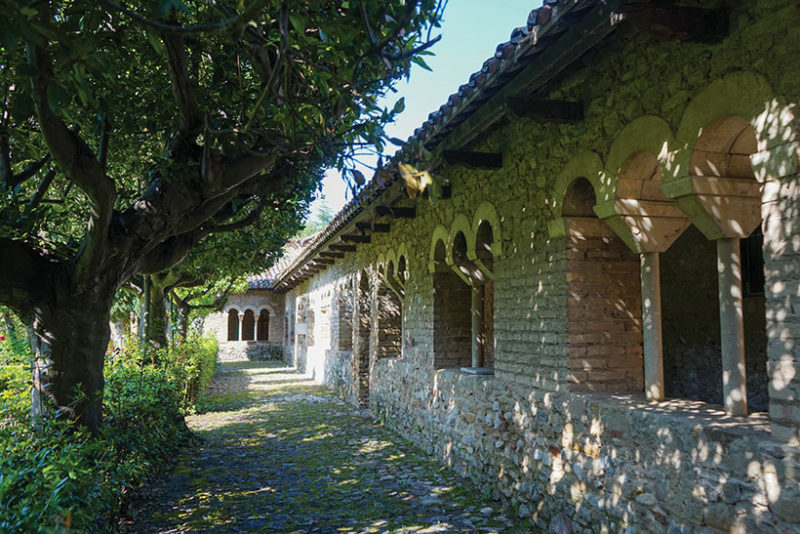
Perched on a Magnificent Promontory overlooking the sandy shores of Fossacesia stands the Abbey of San Giovanni in Venere, a remarkable testament to Benedictine heritage that spans over a millennium.
Originally rising from the grounds of a temple devoted to the goddess Venus Conciliatrice, the abbey commands attention with its grand architecture and refined simplicity. The main façade boasts a stunning marble portal adorned with intricate bas-reliefs, while the crypt showcases ancient frescoes.
Yet, the true gem of San Giovanni in Venere reveals itself within the cloister: a lush Mediterranean garden filled with fragrant blossoms and vibrant green hues. As if that wasn’t enough, the panoramic view of the Trabocchi coastline is breathtaking!
Get more travel inspiration in our Italian holidays archive
Words by Val Nicastro
